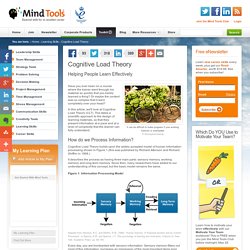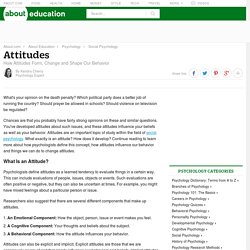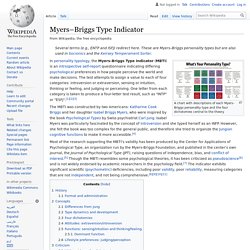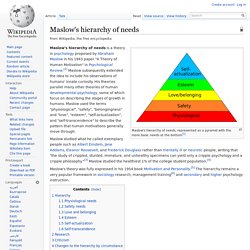

TKI 40th Anniversary. CPP's Professional Services The beauty of the TKI tool is its simplicity.

Not only are the TKI tool and its related reports easy to understand for both you and your employees, but CPP (the exclusive publisher of the TKI, MBTI®, and other assessments) offers booklets, resource training guides, and activities to support you in the implementation of your conflict management program. However, we know how busy you are and that conflict management may not be your area of expertise. Maybe you’d appreciate someone else running the conflict management program. CPP is here to help with that, too. CPP’s Professional Services bring together the world’s most widely used assessment tools and the expert consulting advice you need to speed up organizational learning and develop your most valuable resource—your employees. Our Solutions Consultants can help develop a professional program just for you.
Cognitive Load Theory - Information and Learning Skills From MindTools.com. Helping People Learn Effectively It can be difficult to make progress if your working memory is overloaded.

“Well Mr. President”, the janitor replied “I’m helping to put a man on the moon” During a visit to the NASA space center in 1962, President Kennedy noticed a janitor carrying a broom.

He interrupted his tour, walked over to the man and said, “Hi, I’m Jack Kennedy. What are you doing?” “Well, Mr President” the janitor responded, “I’m helping put a man on the moon.” We love this story because it emphasises the true team ethos developed by NASA. Gut instinct: harnessing the body's brain. Google goes in: Search inside yourself.

Intuition is often made out to be the airy fairy realm of those who carry incense sticks and see auras. But the body's intelligence is something to be taken seriously. An interesting study was done several years ago, by neurologists at the University of Iowa. Brain. Attitudes - How Attitudes Form, Change and Shape Behavior. What's your opinion on the death penalty?

Which political party does a better job of running the country? Should prayer be allowed in schools? Should violence on television be regulated? Chances are that you probably have fairly strong opinions on these and similar questions. Myers-Briggs Type Indicator. Model of personality types A chart with descriptions of each Myers–Briggs personality type and the four dichotomies central to the theory The Myers–Briggs Type Indicator (MBTI) is an introspective self-report questionnaire indicating differing psychological preferences in how people perceive the world and make decisions.[1][2][3] The original versions of the MBTI were constructed by two Americans, Katharine Cook Briggs and her daughter Isabel Briggs Myers.[4] The MBTI is based on the conceptual theory proposed by Swiss psychiatrist Carl Jung,[5] who had speculated that people experience the world using four principal psychological functions – sensation, intuition, feeling, and thinking – and that one of these four functions is dominant for a person most of the time.[6] The four categories are Introversion/Extraversion, Sensing/Intuition, Thinking/Feeling, Judging/Perception.

Each person is said to have one preferred quality from each category, producing 16 unique types. History[edit] Safety leadership. Plete list of short courses - Australian Human Resources Institute. Maslow's hierarchy of needs. Maslow's hierarchy of needs, represented as a pyramid with the more basic needs at the bottom[1] Maslow's hierarchy of needs is a theory in psychology proposed by Abraham Maslow in his 1943 paper "A Theory of Human Motivation" in Psychological Review.[2] Maslow subsequently extended the idea to include his observations of humans' innate curiosity.

His theories parallel many other theories of human developmental psychology, some of which focus on describing the stages of growth in humans. Maslow used the terms "physiological", "safety", "belongingness" and "love", "esteem", "self-actualization", and "self-transcendence" to describe the pattern that human motivations generally move through. Maslow's theory was fully expressed in his 1954 book Motivation and Personality.[5] The hierarchy remains a very popular framework in sociology research, management training[6] and secondary and higher psychology instruction. Hierarchy Physiological needs Safety needs Safety and Security needs include: Risk avoidance and reduction - Operating an effective safety, health and environmental policy - BOC.
We can reduce the number of incidents that affect health, safety and the environment when we understand their cause.

This is particularly true of incidents that result from human error or from a failure to take adequate precautions against risks. Creating a safer and a less environmentally harmful workplace is, therefore, a learning experience that involves: finding out more about the risks associated with activitiesunderstanding better why accidents happen or environmental incidents occurreducing or eliminating the factors that contribute to risk.
Sometimes, hard lessons are learned only through bitter experience. In 2001 in the USA, a young boy visited a hospital to have an MRI (magnetic resonance imaging) scan. The gases industry is potentially hazardous. The industry therefore gives a very high priority to health, safety and environmental considerations. Tuckman team development model.
Professional Resillience. Teamwork Model & Situational Leadership. Leading Culture / Engaging & Influencing. Decision Making & Managing Change.